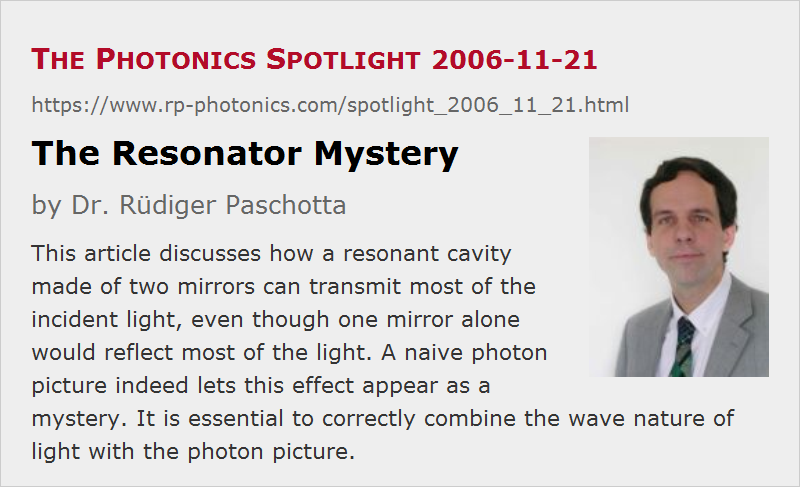The Resonator Mystery
Posted on 2006-11-21 (revised on 2011-06-10) as a part of the Photonics Spotlight (available as e-mail newsletter!)
Permanent link: https://www.rp-photonics.com/spotlight_2006_11_21.html
Author: Dr. Rüdiger Paschotta, RP Photonics Consulting GmbH
Abstract: This article discusses how a resonant cavity made of two mirrors can transmit most of the incident light, even though one mirror alone would reflect most of the light. A naive photon picture indeed lets this effect appear as a mystery. It is essential to correctly combine the wave nature of light with the photon picture.

Ref.: encyclopedia articles on optical resonators, enhancement cavities, Fabry–Perot interferometers, photons
Have you ever wondered how a pair of nearly totally reflecting mirrors, one placed behind the other one, can transmit most of the power of a light beam, while one of those mirrors alone would reflect nearly all the light? It really looks like a mystery if you think of a light beam as consisting of photons. Most of the photons should be reflected when hitting the first mirror, and the second mirror shouldn't be able to affect them at all, as they never hit that one.
This demonstrates quite convincingly that simply regarding a laser beam as a stream of photons won't be compatible with reality. We have to recall the wave nature of light, which allows for interference effects. In the steady state, we have a powerful laser beam circulating in the resonator; its power can be far above that one of the incident beam. This does not only explain how the power transmitted by the second mirror can be comparable to that one of the incident beam, despite the small mirror transmissivity. It also explains why the reflected light can essentially vanish: the reflected beam can be described by the superposition of two amplitudes – one from direct reflection of the incident beam, another one from weak transmission of the intracavity light through the first mirror. In the ideal case with equal mirrors and no optical losses, and with the proper phase relationship of both beams (→ resonance condition fulfilled), the two amplitudes can entirely cancel each other.
It is interesting to consider the turn-on behavior. When the incident light beam is turned on, and no light is in the resonator yet, most of the light will indeed be reflected, and only a small portion gets into the resonator. After each resonator round trip, however, the intracavity light becomes stronger, as more amplitude is added by the incident beam. The stronger this beam becomes, the larger the amplitude of the light leaking out of the resonator, back to the light source. Still assuming resonance, we see the reflected light power getting smaller and smaller.
But why is there initially a strong reflection even if the light is exactly resonant with the cavity from the beginning – is it not that exactly resonant light is always well transmitted? Yes, but a light beam which is turned on at some time cannot be exactly monochromatic. Its finite linewidth explains in the frequency domain why some light can be reflected.
Back to the photon picture, would the high transmission also occur for very small light intensities, where at most one photon is in the setup at any time? Yes, it would – according to the rules of quantum optics, the wave propagation analysis tells us the likelihood of getting the photon transmitted or reflected. It would be wrong to expect that the photon can be only either inside or outside the resonator at any time, making interference of the two contributions to the reflected beam impossible.
But what if I somehow detect that the photon is between the mirrors at some time, so that I know there won't be any light outside? Obviously one should not detect the photon by absorbing it e.g. on a photodiode, but in principle one may do a quantum-non-demolition measurement where the photon is sent through a transparent piece of glass, slightly modifying the phase of a second light beam which also goes through the glass (e.g. at some angle to the original beam). The interaction between the beams would occur through cross-phase modulation. This would in principle allow to detect the photon's presence in the resonator without absorbing it. It turns out, however, that the intensity fluctuations of the second light beam would act back on the phase of the intracavity light (as cross-phase modulation also works that way), causing it to fluctuate. This would affect the interference so that the resonance condition is spoiled.
We see that a naive use of the photon picture can be very misleading. It is essential to correctly combine the wave nature of light with the photon picture.
This article is a posting of the Photonics Spotlight, authored by Dr. Rüdiger Paschotta. You may link to this page and cite it, because its location is permanent. See also the RP Photonics Encyclopedia.
Note that you can also receive the articles in the form of a newsletter or with an RSS feed.
Questions and Comments from Users
Here you can submit questions and comments. As far as they get accepted by the author, they will appear above this paragraph together with the author’s answer. The author will decide on acceptance based on certain criteria. Essentially, the issue must be of sufficiently broad interest.
Please do not enter personal data here; we would otherwise delete it soon. (See also our privacy declaration.) If you wish to receive personal feedback or consultancy from the author, please contact him e.g. via e-mail.
By submitting the information, you give your consent to the potential publication of your inputs on our website according to our rules. (If you later retract your consent, we will delete those inputs.) As your inputs are first reviewed by the author, they may be published with some delay.
 |



If you like this page, please share the link with your friends and colleagues, e.g. via social media:
These sharing buttons are implemented in a privacy-friendly way!